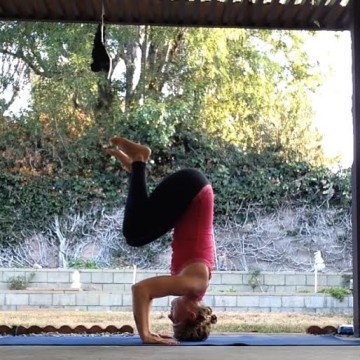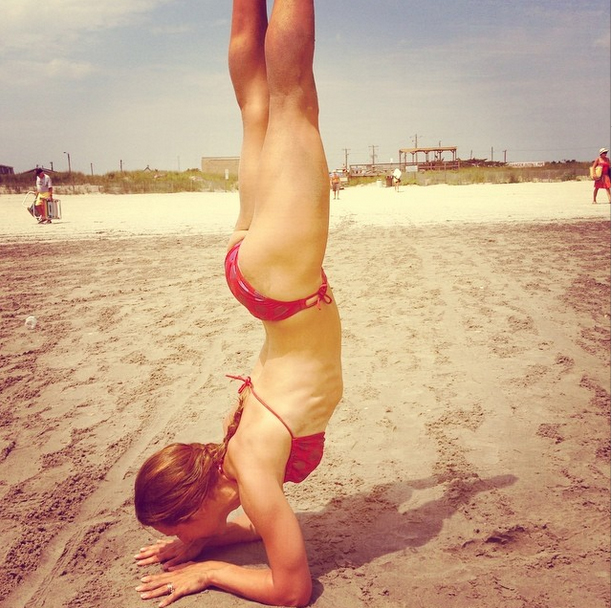Every Thursday, Peaceful Dumpling will answer your question about veganism, healthy eating, lifestyle, fitness, wellness, relationships, and more! Send us your questions to contact [at] peacefuldumpling.com or using the Contact form below.
_______________
I love practicing yoga and seeing tutorials on Peaceful Dumpling. My biggest challenge is definitely inversions. What are some of your tips for getting into a headstand, handstand, etc–and holding it?
Dear Stuck Right-Side-Up:
It’s great that you practice yoga and that you’ve gotten far enough in your practice to even think about inversions! I wasn’t brave enough to try them until about 4 years into regular practice, and even then it was only with help. Inversions, or as I like to call them the “party tricks of yoga,” can completely transform your experience of yoga and require that you master not only the physical, strengthening component but the mental and spiritual awareness that’s yoga’s ultimate goal. Because like most things in life, holding yourself upside down is harder than it looks in a lot of ways, and those ways are different from what you’d expect. Standing on your head, forearms, or hands is less about upper body or core strength than it is about overcoming fear.
Since you have a regular practice, you should first consult your teacher(s) for specific tips relevant to your particular struggles with inversions. I’m not a certified yoga instructor, so my advice is all based on personal experience and should be taken with that amateur’s disclaimer. That being said, I know how you feel about the inability to hold inversions: you hop and you hop and you hop, you get as close to a wall as you can, you can do a million chaturangas no problem and yet you just can’t get yourself upside down for more than a second. And when you do, you’re flooded with some mix of panic and joy that immediately makes you fall over.
A good starting place might be forearm stand at the wall with a block. This inversion puts the most weight-bearing surface area on the ground, and the block provides some extra stability. Set up the block with the long side against the wall and set up your hands so that your thumb and index finger make L shapes on the corners. Come into dolphin pose (a short down dog with your forearms on the ground) with your gaze forward between your hands (not down), and just hold it for a while. Holding a base pose is key in conquering inversions, as it helps set up your alignment and help you visualize where you should be when you’re ultimately upside down. Once your comfortable there, bend one leg and kick the other one, straight, up in the air. Try kicking on both sides a few times, and you’ll quickly find that you favor one leg–try harder on the other one. Kicking is a good place to stay for a while, but if you find that one day your kick takes your heel to the wall, hooray! You did it. You should be able to bring your other leg up to meet it, and when you’re there push your heels up toward the ceiling to prevent arching your back too much. The brick between your hands will help keep your elbows from splaying out, and your forward-gaze helps you from falling on your head. Moving this to the center of the room would be the next step once you’ve been able to balance at the wall.
For headstand, you’ll want to make sure to keep your elbows close together as well, though you can’t use a brick as a guide. Instead hold opposite elbows and keep that distance, maybe a little closer, when you bring the crown of your head down. You’ll start in a similar way to forearms stand: in a short down dog with your head cradled between your hands, forearms down. Your shoulders need to be directly over your elbows for anything to happen: if you’re angled backwards, you’ll have no stable base upon which to shift your weight. Getting yourself perpendicular to the floor but upside down is the scariest thing about all inversions because it’s the opposite of how we humans live their lives. Once you overcome that fear, the rest is easy–pure muscle work: first, lift one leg up into a tuck and hold. Your abs will burn. Add another leg and hold. Holding the tuck is what will allow you to eventually push your legs straight up: I did that for about a year until it was so comfortable I could reasonably persuade myself I was strong enough to go all the way up.
I’d be a hypocrite if I gave advice on holding handstand as after 2 years (yes!) of trying I still can’t do it. I’ve had luck with teacher assists–another good tool to use when you’re almost there–but never on my own, consistently. What I’ve been working on visualizing here is that perpendicular image I mentioned above: you need to be literally on top of your wrists, arms completely straight, to go anywhere. I admit I’m too afraid to put myself there for too long, and without my feet on the floor or a pair of hands holding my feet in the air. Since I’ve held the pose on my own after an assist, I know I’m strong enough: you probably are, too, as once you’re up it’s kind of easy to hold. It’s all in my head at this point, and I’d guess that it what your main struggle might be as well.
As you continue on your yoga journey, don’t beat yourself up for not meeting some expectation of what you should be able to do at a certain point. Overcoming psychological challenges is not like getting a six pack or sculpted triceps: it’s way harder, and your progress is less visual or measurable. Though if when you work on your inversions you start off acknowledging your fear, or whatever is holding you back, and visualizing what it would mean to do the pose without that pulling you down, you may find yourself one day with a new outlook on the world: one where everything is upside down, and rather than being frightened you’re completely in awe of what that view unveils.
More reader questions on Ask Peaceful Dumpling: How Do I Get Out of My Makeup Rut?
How Do I Quiet the “Should” Voices in My Head?
Related: Benefits of Inversions and 4 Poses to Get Started
Learning How to Fall Out of Inversions
__
Photo: Peaceful Dumpling; Anastasia Bailey







